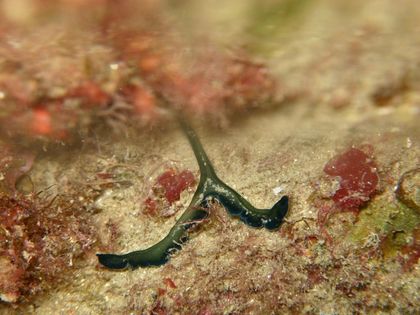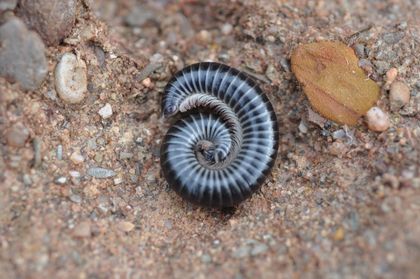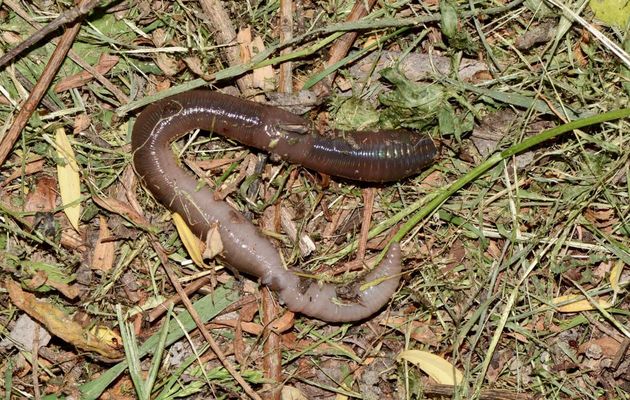However, some of them paid no attention to Moses; they kept part of it until morning, but it was full of maggots and began to smell. So Moses was angry with them.
(Ex. 16:20) You will plant vineyards and cultivate them, but you will not drink the wine or gather the grapes, because worms will eat them.
(Dt. 28:39) My body is clothed with worms and scabs, my skin is broken and festering. (Job 7:5)
 Photo: Antonio Cruz
Photo: Antonio CruzThe word “worm” is common term with many meanings in our language, although almost all of them have no scientific value. However, in ancient times systematic zoology recognised the term Worms to designate different groups of invertebrates that had certain characteristics in common: for example, bilateral symmetry, the absence of jointed appendages, a soft, elongated body, which could be flat (flatworms), threadlike (roundworms) or segmented (annelids).
 Photo: Antonio Cruz
Photo: Antonio Cruz However, at the end of the 19th century, some zoologists began to realise that this type of organism, or the phylum Worms, was much more complex than it seemed and could not continue to be classified as it had been, as such a classification was contrived and did not reflect reality. So, it was substituted for several different natural phyla. Thus the old notion of “worm” is now only applied colloquially (not scientifically) to different groups of organisms: annelids (earthworms and leeches); flatworms (tapeworms, trematodes and planarians); nematodes (intestinal flatworms); onychophora (velvet worms), and so on. The term “worms” is also commonly applied to the larvae of certain insect, such as the caterpillars that attack plants and fruit (the larvae of butterflies); the maggots that devour the carcasses of animals (the larvae of flies) or even to species like centipedes or millipedes. It should be stressed that calling these organisms “worms” is incorrect from a zoological point of view. In the same way the Bible uses the term “worm” to refer to organisms with a soft, elongated body, especially to the larvae of insects (butterflies, flies and beetles) that can destroy crops, fruit of corpses and become pests for humankind. There are three Hebrew terms that reflect certain other aspects of the concept of “worm” in Scripture. The first is rimmah, (Sept. skólex, sepsis, sapría; Vulg. vermis, putredo, tineas), and refers both to vermiform worms and to the larvae of several insects that feed on corpses, but not to earthworms. It is a word that is related to the sickness, death and decomposition of human bodies (Job 7:5; cf. 17:14; 21:26; 24:20). The second term is tolá (Ex. 16:20; Is. 1:18; Lam. 4:5), the feminine form toleah, or toláath, (Dt. 28:39; Job 25:6; Sal. 22:6; Is. 14:11; 41:14; 66:24; Jonah 4:7) and refers to any invertebrate animal that crawls along the ground. In the Septuagint it is translated as skólex, and in the Latin Vulgate as vermis. The term is used for the worms that appeared in the manna of the distrustful Israelites who keep some in reserve for the following day (Exodus 16:20). It is also used in the book of Job to compare the human being with his Creator: How much less man, that is a worm! And the son of man, that is a worm! (Job 25:6).
 Photo: Antonio Cruz
Photo: Antonio CruzFinally, the third Biblical term for “the worm that does not die” is the already mentioned Greek term, skólex, which appears in the New Testament to refer to Hell, or the permanence of eternal death (Mark 9:44, 46 and 48). It is an expression taken from the Old Testament (Isaiah 66:24) to indicate eternal punishment. Likewise, it is used in the book of Acts to describe the terrible death suffered by Herod Agrippa: Immediately, because Herod did not give praise to God, an angel of the Lord struck him down, and he was eaten by worms and died. (Acts 12:23) The psalmist echoes the idea already referred to in Job (25:6) and says: But I am a worm and not a man, scorned by everyone, despised by the people. (Psalm 22:6). These very words can be applied to Christ as he was insulted, mocked, spat upon, struck in the face, whipped, tortured and trampled upon as if he were a vile worm and not a good man who had only ever done good to everyone. The Son of God not only stooped to the point of becoming a human being, out of his love for humankind, but was treated more like a worm than as a person.
 Photo: Antonio Cruz
Photo: Antonio CruzThe Hebrew word that is translated here as “worm” refers to the scarlet or crimson worm, which appears on the large leaves of the prickly pear, and from which a famous scarlet dye is extracted. The symbolism is clear: the body of Jesus Christ was also stained red when he hung on the cross, due to the blood from his wounds. Red blood poured out so that crimson-stained human evil could be washed and be made whiter than snow (Isaiah 1:18). It is for this reason that we Christians need to keep this paradox of the cross alive and continue to preach it every day.
 Photo: Antonio Cruz
Photo: Antonio Cruz
 Photo: Antonio Cruz
Photo: Antonio Cruz
 Photo: Antonio Cruz
Photo: Antonio Cruz Photo: Antonio Cruz
Photo: Antonio Cruz Photo: Antonio Cruz
Photo: Antonio Cruz Photo: Antonio Cruz
Photo: Antonio Cruz Photo: Antonio Cruz
Photo: Antonio Cruz